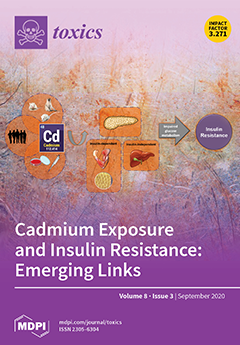Lead (Pb) is a toxic metal known for its wide-ranging adverse health effects. However, a compound of Pb is still used in the caulking process to repair wooden fishing boats. The present study aimed to measure Pb exposure and its immunologic effects in boatyard workers in Nakhon Si Thammarat province, Thailand, in comparison with an age-matched control group of farmers. The age, body mass index, and smoking history in workers (
n = 14) and controls (
n = 16) did not differ. The median blood Pb concentration was 8.7-fold higher in workers than controls (37.1 versus 4.3 µg/dL,
p < 0.001). Workers had 8.4% lower phagocytic active cells than controls (89.9% versus 98.1%,
p = 0.019). In response to a mitogen stimulation, the peripheral blood mononuclear cells (PBMCs) from workers produced 2-fold higher ratios of interleukin-4 (IL-4) to interferon-γ than the PBMCs from controls (
p = 0.026). Furthermore, Pb-exposed workers had 33.9% lower cytotoxic T (Tc) cells than controls (24.3% versus 36.8%,
p = 0.004). In stark contrast, the percentage of regulatory T (Treg) cells in workers was 2.7-fold higher than controls (6.1% versus 2.3%,
p < 0.001). In all subjects, blood Pb showed positive correlations with the percentages of Treg cells (
r = 0.843,
p < 0.001) and IL-4 (
r = 0.473,
p = 0.041) while showing an inverse correlation with the percentages of Tc cells (
r = −0.563,
p = 0.015). These findings indicate that chronic high Pb exposure may cause a shift towards humoral immune response, together with a suppression of cellular immunity, thereby suggesting an elevation in cancer risk in Pb-exposed workers.
Full article






